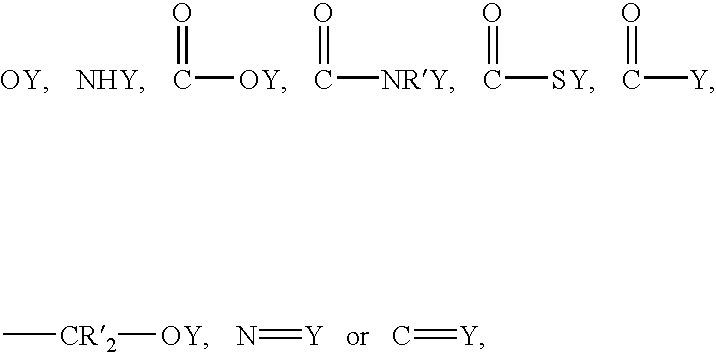Graphitic nanotubes in luminescence assays
a technology of luminescence assay and graphitic nanotube, which is applied in the direction of digital storage, catalyst carriers, carbon compounds, etc., can solve the problems of poor prediction of nanofiber chemistry by continuous fibers and the inability of tunneling phenomena to operate for very short distances, and achieve the effect of high light emission
- Summary
- Abstract
- Description
- Claims
- Application Information
AI Technical Summary
Benefits of technology
Problems solved by technology
Method used
Image
Examples
third embodiment
[0159] In a third embodiment, the fibrils may be removed by filtration from the assay composition. In this embodiment the particles need not have a density greater than the balance of the assay composition. The fibrils are separated from the solution and concentrated by drawing the solution through a filter, e.g. pumping and collecting the particles on the surface of the filter. This surface of the filter is, for example, coated with a thin metal film which can serve as the working electrode in an ECL detection system.
[0160] In another embodiment, the suspended fibrils are magnetically responsive, e.g. they may be paramagnetic or ferromagnetic, and are collected in a measurement zone or, preferably, directly at the surface of an electrode, by imposition of a magnetic field on the particles. The measurement cell is equipped with a magnet. The magnetic field of the magnet applies a force on the particles as they reside in a batch cell or as they flow through a flow cell, causing them ...
preparation b
Preparation of Functionalized Fibrils by Reacting Acrylic Acid with Oxide-Free Fibril Surfaces
[0235] One gram of BN fibrils in a porcelain boat is placed in a horizontal 1" quartz tube fitted with a thermocouple and situated in a Lindberg tube furnace. The ends are fitted with a gas inlet / outlets. The tube is purged with dry, deoxygenated argon for 10 minutes, after which the temperature of the furnace is raised to 300.degree. C. and held for 30 minutes. Thereafter, under a continued flow of argon, the temperature is raised in 100.degree. C. increments to 1000.degree. C., and held there for 16 hours. At the end of that time, the tube is cooled to room temperature (RT) under flowing argon. The flow of argon is then shunted to pass through a multi-neck flask containing neat purified acrylic acid at 50.degree. C. and fitted with gas inlet / outlets. The flow of acrylic acid / argon vapors is continued at RT for 6 hours. At the end of that time, residual unreacted acrylic acid is removed, f...
preparation d
Preparation of Functionalized Fibrils by Reacting Maleic Acid with Oxide-Free Fibril Surfaces
[0237] The procedure is repeated as in Preparation B, except that the reactant at RT is purified maleic anhydride (MAN) which is fed to the reactor by passing argon gas through a molten MAN bath at 80.degree. C.
Preparation E
Preparation of Functionalized Fibrils by Reacting Acryloyl Chloride with Oxide-Free Fibril Surfaces
[0238] The procedure is repeated as in Preparation B, except that the reactant at RT is purified acryloyl chloride, which is fed to the reactor by passing argon over neat acryloyl chloride at 25.degree. C. Acid chloride content is determined by reaction with excess 0.100N NaOH and back-titration with 0.100N HCl.
[0239] Pyrolysis of fibrils in vacuum deoxygenates the fibril surface. In a TGA apparatus, pyrolysis at 1000.degree. C. either in vacuum or in a purified Ar flow gives an average wt loss of 3% for 3 samples of BN fibrils. Gas chromatographic analyses detected only CO ...
PUM
| Property | Measurement | Unit |
|---|---|---|
| distance | aaaaa | aaaaa |
| distance | aaaaa | aaaaa |
| diameter | aaaaa | aaaaa |
Abstract
Description
Claims
Application Information
 Login to View More
Login to View More - R&D
- Intellectual Property
- Life Sciences
- Materials
- Tech Scout
- Unparalleled Data Quality
- Higher Quality Content
- 60% Fewer Hallucinations
Browse by: Latest US Patents, China's latest patents, Technical Efficacy Thesaurus, Application Domain, Technology Topic, Popular Technical Reports.
© 2025 PatSnap. All rights reserved.Legal|Privacy policy|Modern Slavery Act Transparency Statement|Sitemap|About US| Contact US: help@patsnap.com



